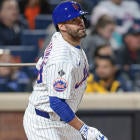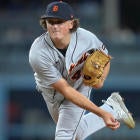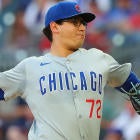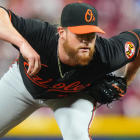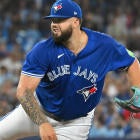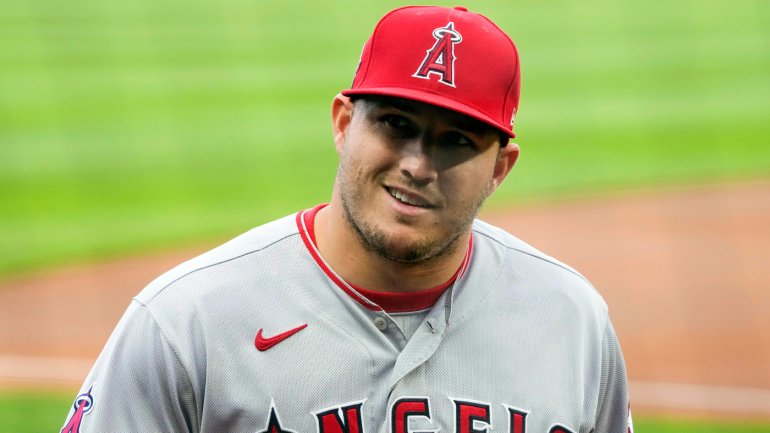
Try as you might to be as rational as possible while playing Fantasy baseball, we all know it's not possible. As much as we all might want to think all of our research represents a dispassionate search for an objective truth that will lead us to a championship, there's no getting around this simple fact: We're all human.
And, while we might be near the top of the leaderboards on the planet Earth in terms of our ability to remain objective, that's not really saying much; I might not fall prey to the "fake tennis ball throw" trick as often as my year-old labrador puppy does, I'm pretty liable to fall for the "my breakout pick had a good first two weeks and now I'm a genius" trick. And I bet you are too. It's natural!
The problem is, because the start of the season means the first real baseball we've seen in months, it can often mean our opinions about players tend to calcify early on, and it can be hard to change them. Two weeks or a month in April don't necessarily mean anything more than two weeks in May or July or any other time of the year, but those two weeks in April can hold an inordinate amount of meaning in how we perceive players.
With that in mind, I figured the mid-way point of May was a good time to look at who has had the biggest difference in production between the first month of the season and the first couple of weeks in May. In this piece, I'm looking for players who have slowed down since that first month, to see if there might be reason to worry, or perhaps a buy opportunity if there isn't.
Here are the 10 players who have seen their wOBA shrink the most since the calendar turned to May:
| |
April wOBA |
May wOBA |
DIFF |
| 0.539 |
0.324 |
-.215 |
|
| 0.36 |
0.195 |
-.165 |
|
| 0.43 |
0.277 |
-.153 |
|
| 0.486 |
0.339 |
-.147 |
|
| 0.492 |
0.349 |
-.143 |
|
| 0.398 |
0.276 |
-.122 |
|
| 0.395 |
0.289 |
-.106 |
|
| 0.366 |
0.266 |
-.100 |
|
| 0.309 |
0.216 |
-.093 |
|
| 0.369 |
0.28 |
-.089 |
Mike Trout
Some awfully big names on that list, and none bigger than at the top. Of course, some context is called for: Trout's .324 May wOBA would still rank in the 42nd percentile for the league overall this season. Even when he's slumping, he's still pretty good.
Trout has seen his strikeout rate jump from 26.1% in April to 30.8% in May, and that's the key difference here. And it's actually been an issue since the start of the season. He's swinging more often overall, but his swing rate on pitches outside of the zone (22.3%) would actually only be his fifth-highest ever, and isn't far off from 2018, when he swung at 21.8% of pitches outside of the zone but had just a 20.8% strikeout rate.
The issue isn't plate discipline, necessarily, it's a contact issue: Trout is sporting a career-low 74.7% contact rate on swings -- his previous low was 79.9%. And it's especially been an issue on pitches in the strike zone, as he's gone from ranking 38th out of 164 hitters on in-zone contact rate from 2018 through 2020 at 89.7% to 129 out of 162 at 80.4% so far in 2021.
It's weird to say about a guy hitting .336/.464/.637, but Trout has seemingly been just a little off so far. In addition to those strikeout and swinging strike issues, his average launch angle is down to 12.3 degrees, from over 22% in each of the previous seasons and over 18% since 2017. He's hitting the ball on the ground more than he has since his rookie season, and that's played a part in his lowest expected ISO based on StatCast data since 2016.
Of course, this is all relative; Trout ranks 14th in hard-hit rate and 12th in expected wOBA for the season. However, his recent slide is showing some ever-so-small cracks in the armor. Trout is still likely to be one of the best hitters in Fantasy moving forward, and I would bet strongly on his strikeout rate regressing to his career norms before long. There's not much actionable here -- you're unlikely to be able to buy Trout at any kind of discount even with a few subpar weeks, and you certainly shouldn't be looking to sell him -- but it's worth noting, at least.
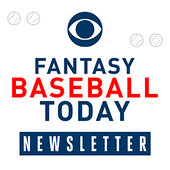
Fantasy Baseball Today Newsletter
Your Cheat Code To Fantasy Baseball
You're destined to gain an edge over your friends with advice from the award-winning FBT crew.
Thanks for signing up!
Keep an eye on your inbox.
Sorry!
There was an error processing your subscription.
Eduardo Escobar
Escobar's May numbers include his two-homer game Saturday, so you know things were especially bad before that. Escobar was seemingly seriously pressing before Saturday, as he sports an ugly 30.2% strikeout rate with just a 3.8% walk rate; in April, that was 18.3% and 8.3%, respectively.
Escobar is coming off a ghastly 2020 that saw him hit just .212/.270/.335, and while his underlying numbers are better pretty much across the board, it's hard to see him getting back to the 2019 form that saw him drive in 118 runs with 35 homers and hit 74 extra-base hits. He's seemingly selling out for power more than ever, with a career-high 22.3 degree average launch angle, but with the ball not traveling as far this season, that's not a great strategy, and that trend got worse, not better in May; his average launch angle was 26.3 degrees, the highest in baseball. For a guy with middling raw power, that's not a viable approach, and it's hard to see much reason to view him as more than a fringe Fantasy option at this point.
We broke down other struggling players and what to do with them including Lucas Giolito on the latest Fantasy Baseball Today podcast. You can subscribe to make sure you get the latest episodes of Fantasy Baseball Today right when they drop on Apple and Spotify.
Nelson Cruz
When you're talking about a 40-year-old, you always have to be on the lookout for signs of skills decline. Cruz is striking out slightly more in May than he was in April and he is hitting the ball less hard and on the ground more frequently than he did, too. But we're talking about relatively small changes across the board, and Cruz is still crushing the ball overall -- his hard-hit rate in May is 50%. There will always be people looking for evidence that Cruz is finally falling off, but this isn't it.
Vladimir Guerrero Jr.
From April 28 -- the day after his three-homer game -- through May 13, Guerrero looked like the poster boy for this exercise, as he had fallen into a .231/.355/.327 slump with just one homer and two doubles in 14 games. Except now he's homered in three straight after his 3-for-5, two-RBI showing Sunday. His plate discipline has been a tad worse in May, his launch angle is a tad down, and he's fallen from elite in hard-hit rate to more like above-average, and given how big an outlier his April was from his first two seasons, you can't exactly write off any dip as just noise. But you're not going to find me expressing much skepticism about Guerrero at this point. I already made that mistake before the season, and as long as he keeps elevating the ball -- 8.2 degree average launch angle in May is still nearly double 2020's mark -- I won't doubt him.
J.D. Martinez
Martinez isn't nearly as old as Cruz is, but given his struggles in 2020, there were even more questions about his ability to rediscover his old form coming into 2021. His April put those to rest, and even a slower May shouldn't scare you much, because there isn't much to be worried about when you check under the hood. He still looks a lot more like the 2019-and-earlier version of himself than the 2020 version, and that's all we want to see. There's no need to sell here.
Michal Brantley
Here's another older guy seemingly moving in the wrong direction, except just like Cruz and Martinez, I see no reason to really worry. For one thing, it's unlikely anyone's going to be beating down your door for a 34-year-old Michael Brantley, even when things are going well. We know who he is at this point, and that's a batting average specialist who will give you pretty average production everywhere else. That's what he looks like yet again this season.
Nick Solak
And here's a player we truly don't know what to make of. He was quite good in a small sample size in 2019, pretty bad in a bigger-but-still-quite-small sample in 2020, and now he's been up and down so far this season. In Solak's case, I'm inclined to believe there's a bit of a breakout happening here, in part because the underlying numbers in May are actually quite a bit better than they were in April; his strikeout rate, walk rate, average exit velocity, and hard-hit rate have all moved in the right direction despite his lesser production. I don't know if Solak is a star, but I think he can at least keep something like what he's done so far -- maybe even with more steals.
Carlos Correa
I'm pretty invested in Correa having a bounceback season, so it's distressing to see him fail to keep up the hot start. However, as with Solak, there isn't actually much to be pessimistic about here because Correa's underlying numbers mostly suggest he hasn't actually been much worse. His strikeout rate is up so far in May, but he's also walking more and has a higher average exit velocity and hard-hit rate in the month, too. Correa is underperforming his expected wOBA by .034, and while there are still some issues with how that is being calculated that make it tough to trust with the new baseball, the gap between Correa's expected stats and what he's actually produced is large enough to say there's probably been at least a little bit of bad luck here. He'll be better moving forward.
Manuel Margot
Margot has also suffered through a bit of poor luck, but in his case, it's hard to get too worked up about it. Margo is just a category-league specialist, so if he was hitting .260 instead of .229, he'd be a more valuable stolen base specialist, but you'd still be looking at just 1.5-category contributions. If you're looking for a reason to be optimistic, it's not in the bat, but on the base paths -- he should get to 20 steals if he keeps running at his current pace, and you could expect a few more attempts if the average did improve.
Freddie Freeman
Freeman was disappointing in April, and he's been a flat-out problem spot in your lineup in May. But it doesn't matter, does it? He's earned some of his poor play in May, but he also has such a long track record of elite production that there's no real justification for being concerned at this point. These kinds of ebbs and flows happen, and even his poor May isn't really unprecedented -- he had a 12-game stretch to close out 2019 with a .209 wOBA, and had two separate stretches in 2018 with a wOBA under .230. If you have Freeman, don't sell him; if you don't have Freeman and someone is willing to sell him for even a minor discount, do what you can to get him on your side.














